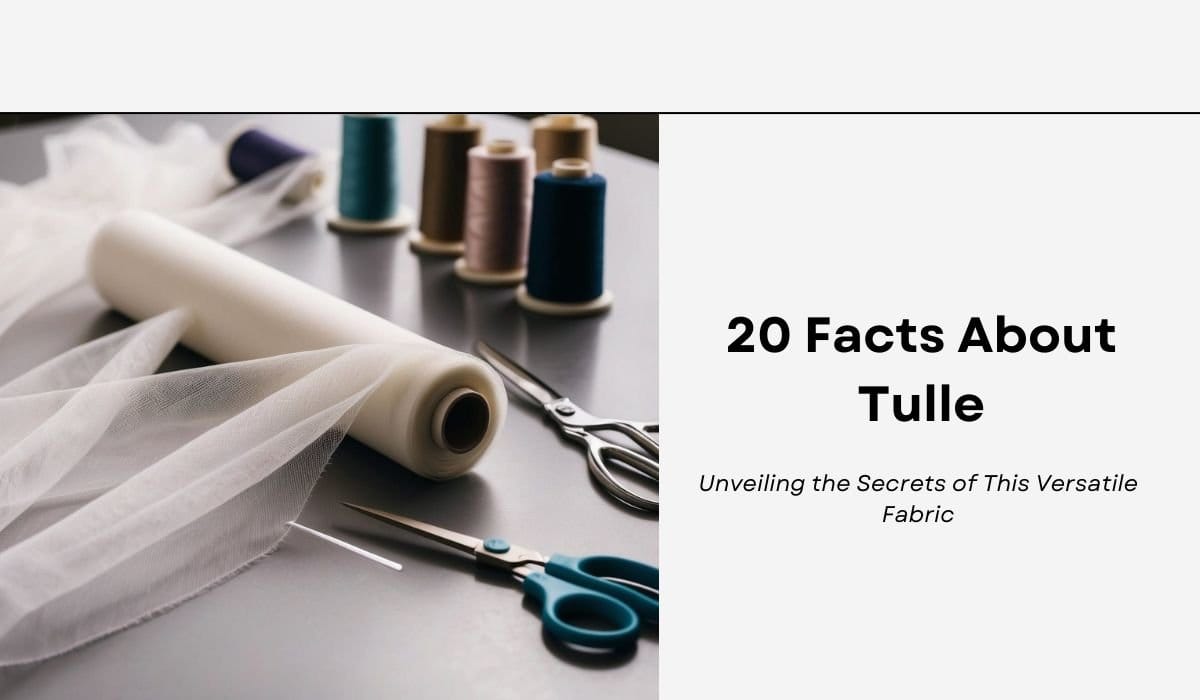From Royal Courts to Modern Fashion: The Fascinating Evolution of Fashion’s Most Romantic Fabric
Tulle fabric is a delicate and versatile material that has captivated designers and crafters for centuries. This lightweight netting, with its distinctive hexagonal pattern, adds a touch of elegance to any project. Tulle is made from various fibres, including silk, nylon, and polyester, each offering unique properties for different applications.
From wedding veils to ballet tutus, tulle has become a staple in the fashion world. Its ability to create volume and ethereal effects makes it a favourite for special occasion wear. Beyond fashion, tulle finds its way into home decor, party decorations, and even theatrical set designs.
As we explore 20 fascinating facts about tulle, you’ll discover the rich history and diverse uses of this enchanting fabric. Whether you’re a bride-to-be, a costume designer, or simply curious about textiles, these insights will deepen your appreciation for tulle’s enduring charm.
On This Page
Key Takeaways
- Tulle fabric is a fine netting with a hexagonal pattern, available in various fibres and stiffness levels
- The fashion industry widely uses tulle for bridal wear, formal gowns, and ballet costumes
- Proper care and innovative applications have expanded tulle’s use beyond traditional fashion into home decor and crafts
The History and Evolution of Tulle
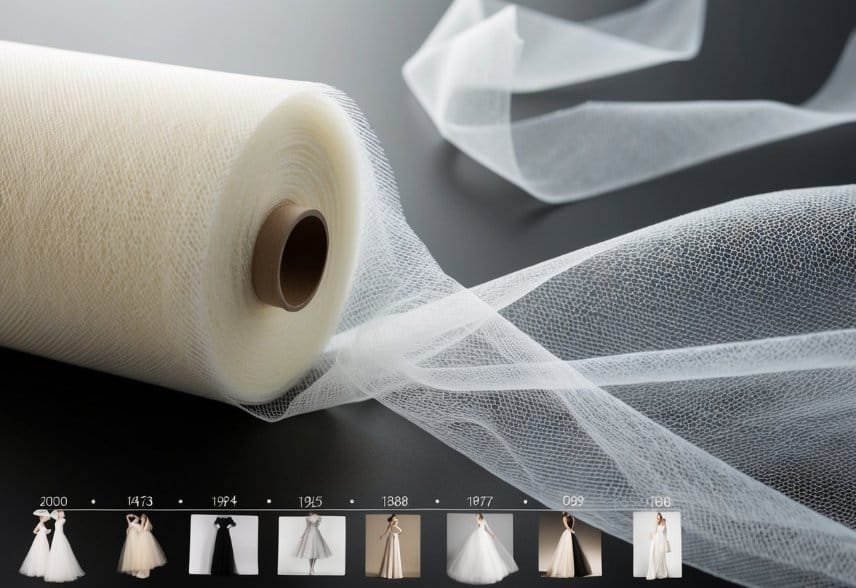
Tulle has a rich past spanning centuries. This delicate fabric has shaped fashion and dance, leaving its mark on both haute couture and ballet costumes.
Early Beginnings and Fashion Milestones
Tulle fabric emerged in the early 19th century in France. It was named after the town of Tulle, known for its lace-making. At first, tulle was a luxury item used for veils and posh frocks.
As time went on, tulle became more common. It found its way into evening gowns and wedding dresses. The light, airy fabric added a touch of magic to formal wear.
In the 20th century, tulle hit the big time. Fashion houses like Dior and Balenciaga used it in their designs. It became a symbol of grace and femininity in high fashion.
Influence on Ballet and Dance Costumes
Tulle made a huge splash in the world of dance. It became the go-to fabric for ballet tutus. The history of tulle in ballet is closely tied to Marie Taglioni.
Taglioni was a famous ballerina in the 1830s. She wore a tulle skirt that showed off her ankles. This was quite daring at the time! Her tutu started a trend that changed ballet fashion forever.
Tulle tutus allow dancers to move freely. They create a floating effect on stage. This makes the dancers look light and graceful as they leap and twirl.
Today, tulle is still a key part of ballet costumes. It’s used in both classical and modern dance performances. The fabric’s ability to catch the light adds to the magic of dance shows.
Understanding Tulle Fabric
Tulle is a lightweight, sheer netting fabric with small hexagonal holes. It comes in various materials and types, each with unique features suited for different uses.
Different Types and Characteristics
Tulle fabric is known for its soft, flowy nature. It has a delicate appearance and smooth texture. The fabric’s strength varies based on the material used.
Cotton tulle is breathable and soft. It’s often used for clothing and decorations. Polyester tulle is durable and affordable. It’s popular for tutus and wedding decor.
French tulle has a finer mesh and softer feel. It’s prized for high-end fashion. English tulle is known for its stiffness and is used in formal wear.
Italian tulle is luxurious and often used in bridal veils. It has a soft drape and elegant sheen.
Silk, Nylon, and Synthetic Varieties
Silk tulle is the most luxurious type. It’s soft, light, and has a natural sheen. French silk tulle is especially fine and delicate. It’s often used in high-end bridal wear.
Nylon tulle is strong and flexible. It’s commonly used in ballet tutus and formal gowns. Nylon tulle holds its shape well and is less likely to snag.
Synthetic tulle like polyester is affordable and widely available. It comes in many colours and is easy to care for. This type is often used for crafts and decorations.
Each material has its own look and feel. Silk is soft and drapey, while nylon is crisp and bouncy. Synthetic tulle can vary in texture but is generally stiffer than natural fibres.
Tulle in Bridal Fashion
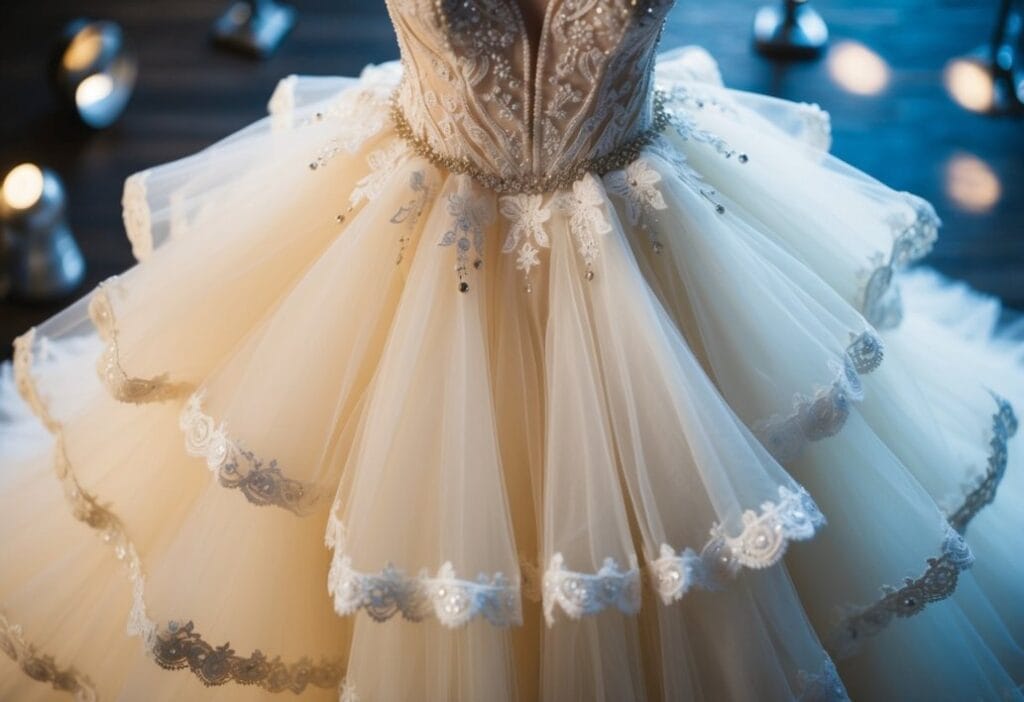
Tulle plays a starring role in bridal fashion, adding ethereal beauty to wedding attire. This delicate fabric creates magical veils and dreamy gowns that captivate brides and guests alike.
Wedding Veils and Bridal Gowns
Tulle is the most common fabric for wedding veils. Its sheer, lightweight nature allows for graceful draping and movement. Brides can choose from various tulle types:
- English Tulle
- Illusion Tulle
- Whisper Tulle
- Silk Tulle
- Italian Tulle
Each type offers unique qualities in texture and appearance. For bridal gowns, tulle adds volume and romance to skirts and trains. It creates stunning ballgown silhouettes and soft, flowing A-line dresses.
Tulle can be layered for added fullness or used as an overlay for a sheer, dreamy effect. Many designers incorporate tulle details like ruffles or bows to enhance a gown’s charm.
Contemporary Designs and Styles
Modern bridal fashion embraces tulle in innovative ways. Designers use tulle to create whimsical and romantic wedding dresses. Some popular styles include:
- Illusion necklines and sleeves
- Tiered tulle skirts
- Coloured tulle for a subtle tint
- Embellished tulle with beading or embroidery
Brides now opt for shorter veils or unique tulle accessories like capes or boleros. Some choose tulle overskirts for a transformable look.
Designers also experiment with different tulle textures and patterns. Dotted tulle adds visual interest, while stiff tulle creates structured, avant-garde designs.
Everyday Fashion and Special Occasions
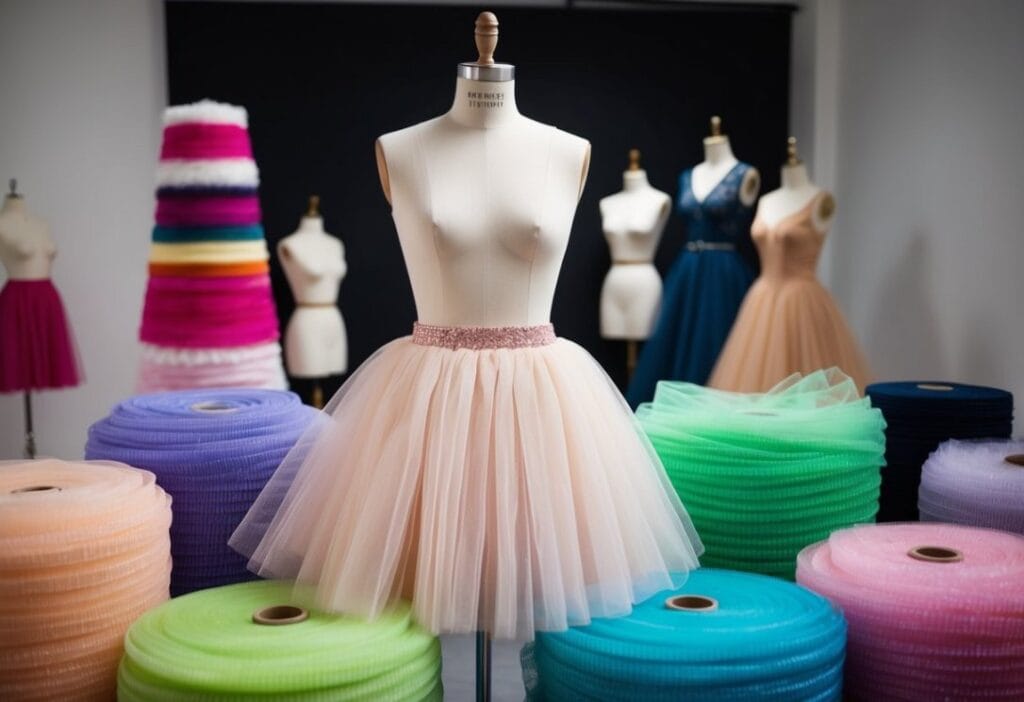
Tulle fabric has become a versatile material in fashion, gracing both casual outfits and formal attire. Its delicate nature adds a touch of whimsy to everyday looks whilst creating stunning effects in evening wear.
Tulle in Casual Wear and Evening Attire
Tulle has found its place in everyday fashion, appearing in skirts, dresses, and tops. A tulle skirt paired with a simple t-shirt creates a playful daytime look. Designers have incorporated tulle into blouses, adding soft ruffles or sheer overlay panels for a feminine touch.
For evening wear, tulle truly shines. It’s a staple in high fashion gowns, creating voluminous silhouettes that catch the eye. Layered tulle skirts add drama to cocktail dresses, whilst sheer tulle sleeves or necklines lend an air of elegance to formal attire.
Fashion designers often use tulle to craft show-stopping red carpet looks. Its ability to hold shape makes it perfect for creating dramatic, sweeping gowns that command attention.
Accessorising with Tulle
Tulle isn’t limited to clothing; it’s a popular choice for accessories too. Delicate tulle hair bows or fascinators add a soft, romantic touch to any outfit. Brides often opt for tulle veils to complete their wedding day look.
In evening wear, tulle wraps or stoles offer a light, ethereal layer over sleeveless gowns. Tulle gloves, popular in vintage-inspired fashion, bring a touch of old Hollywood glamour to formal ensembles.
For a subtle nod to the trend, tulle-trimmed shoes or bags can elevate a simple outfit. Even men’s fashion incorporates tulle, with designers using it for avant-garde runway pieces or as detailing on formal wear.
Tulle in Arts and Crafts
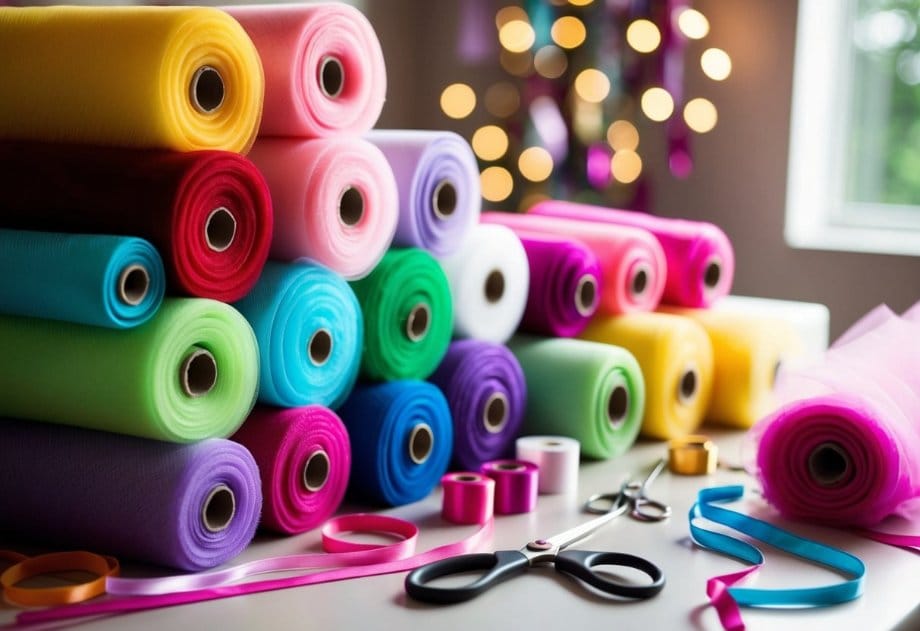
Tulle fabric adds a whimsical touch to various creative projects. Its versatility shines in home decor, event decorations, and DIY crafts.
Home Decor and Event Decorations
Tulle transforms ordinary spaces into dreamy settings. For home decor, tulle can be used in quilting and flower arranging to add texture and body. It’s perfect for creating ethereal curtains or canopies over beds.
In event decorations, tulle is a staple. It’s used to craft elegant table runners, chair sashes, and ceiling drapes for weddings and parties. Tulle bows and pom-poms add a festive touch to gift wrapping and centrepieces.
Tulle’s sheer nature makes it ideal for layering. Multiple colours can be combined to create depth and interest in backdrops or photo booth setups.
Creative Crafting Techniques
Crafters love tulle for its versatility. It’s often used in costume-making, particularly for ballet tutus and fairy wings. Tulle’s soft texture and sheer appearance make it perfect for a wide range of decorative uses.
DIY projects with tulle include:
- Creating no-sew tutus for children
- Fashioning decorative wreaths
- Making pom-poms for gift toppers or garlands
- Crafting delicate flower arrangements
Tulle can be easily dyed, painted, or embellished with glitter or sequins. This allows crafters to customise it for specific projects or colour schemes.
Proper Care and Maintenance
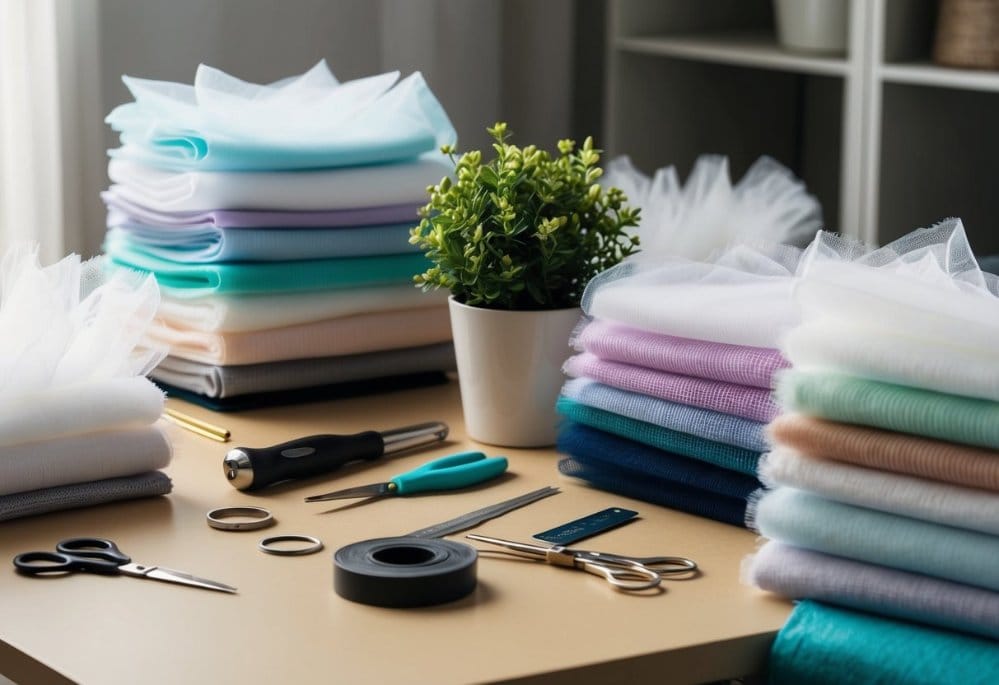
Tulle requires gentle handling and specific care techniques to keep it looking its best. Proper washing methods and storage practices help prevent damage and extend the life of this delicate fabric.
Washing and Handling Delicate Tulle
Caring for tulle starts with gentle washing. Use cold water and mild detergent to clean tulle items.
Hand washing is often the safest method. Fill a basin with cool water and add a small amount of gentle soap. Submerge the tulle and gently swish it around.
Avoid wringing or twisting the fabric. Instead, press out excess water by gently squeezing. Rinse thoroughly in cool water until all soap is removed.
For drying, lay the tulle flat on a clean towel. Reshape it carefully and allow it to air dry away from direct heat or sunlight.
Avoiding Damage and Prolonging Life
To keep tulle looking its best, store it properly when not in use. Hang tulle items on padded hangers to prevent creasing.
Avoid storing tulle in plastic bags, which can trap moisture. Instead, use breathable garment bags or cotton sheets to protect from dust.
Be cautious with jewellery and rough surfaces that could snag the delicate mesh. Remove tulle items carefully to prevent tears.
For wrinkles, use a steamer on the lowest setting. Hold it several inches away from the fabric and work in gentle, sweeping motions.
Spot clean small stains promptly with a damp cloth and mild soap. Blot gently rather than rubbing to avoid damaging the delicate fibres.
Innovative Uses of Tulle Beyond Fashion
Tulle fabric has found its way into many creative applications outside of clothing and accessories. Its lightweight, airy quality makes it ideal for adding visual interest and texture to various projects.
Tulle in Interiors and Floral Designs
Tulle has become a popular material for interior design and floral arrangements. In home decor, tulle can create elegant window treatments, adding a soft, dreamy feel to rooms. It’s often used to craft decorative accents like garlands, bows, and table runners for special events.
Florists use tulle to enhance bouquets and centrepieces. The fabric’s translucent nature allows flowers to show through while adding volume and a delicate touch. Tulle can be shaped into pom-poms or wrapped around vases for a whimsical effect.
For weddings and parties, tulle transforms venues into magical spaces. It’s draped from ceilings, wrapped around pillars, or used to create backdrops. The fabric’s versatility allows for endless creative possibilities in event styling.
Tulle as a Versatile Material for DIY Projects
DIY enthusiasts have embraced tulle for its affordability and ease of use. Crafters use it to make no-sew tutus, a popular choice for children’s costumes and dance wear. Tulle is also perfect for creating decorative wreaths, adding a light, airy touch to seasonal decor.
In gift wrapping, tulle serves as an elegant alternative to traditional paper or ribbons. It’s used to make gift bags, bows, and pompoms that add a special touch to presents. Tulle’s transparency makes it ideal for creating unique lampshades, allowing soft light to filter through.
For home organisation, tulle can be fashioned into storage bags for produce or bath toys. Its mesh-like structure allows for airflow, making it useful for drying herbs or creating sachets. Crafters also use tulle in sewing projects to add volume to skirts or create intricate embellishments on clothing and accessories.
Frequently Asked Questions
Tulle fabric has many interesting properties and uses in fashion. Its rich history and unique production methods make it a versatile material for various garments and accessories.
What are the primary uses of tulle in garment construction?
Tulle is widely used in bridal veils and evening wear. It adds volume and drama to skirts and dresses. Designers often use tulle to create layers in ball gowns and tutus.
The fabric is also popular for decorative elements like bows and ruffles. Its sheer nature makes it ideal for overlays on other fabrics.
How is tulle fabric produced?
Tulle is made through a specific weaving process. It involves twisting fine threads to create a hexagonal net-like pattern. This gives tulle its characteristic lightweight and see-through appearance.
Different materials can be used to make tulle. Common options include nylon, polyester, and silk. Each type of tulle has slightly different properties.
What historical significance does tulle hold in fashion?
Tulle has been a staple in fashion since the 18th century. It gained popularity in the 20th century as a symbol of femininity and grace. Many haute couture designers have featured tulle in their collections.
The fabric has been worn by celebrities on red carpets, further cementing its status in high fashion. Its timeless appeal continues to influence modern designs.
Can you describe the unique properties and benefits of tulle?
Tulle is known for its sheer and gauzy texture. It can hold a stiff shape, making it perfect for creating volume. The fabric is lightweight yet durable.
Tulle allows for airflow, making it comfortable to wear. Its versatility means it can be used in various ways, from delicate veils to structured skirts.
Why is the city of Tulle significant in relation to tulle fabric?
The city of Tulle in France is where tulle fabric was first manufactured. This occurred in the 18th century. The fabric’s name comes directly from this city.
Tulle’s origin in this French city gives the fabric a rich heritage. It connects the material to a long tradition of textile production in the region.
What are the differences between silk tulle and other types of tulle?
Silk tulle is considered a luxury version of the fabric. It has a softer feel and more delicate appearance than nylon or polyester tulle. Silk tulle drapes more elegantly and has a natural sheen.
Nylon and polyester tulle are more common and affordable. They tend to be stiffer and more durable than silk tulle. These synthetic options are often used for crafts and less formal garments.
Related Post: What You Need to Know About Tulle: Essential Facts for Fabric Enthusiasts

